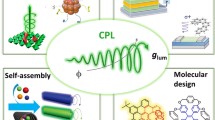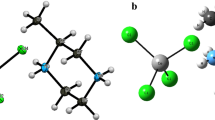Abstract
A suitable substitution of carbazole with a π-spacer group like cyanoethynylethene offers exciting future opportunities in terms of smart nonlinear optical material. In the quest of better organic nonlinear optical material, we have designed a series of derivatives based on carbazole and cyanoethynylethene fragment combinations in a unique fashion by employing the density functional (DFT) methods. The calculated time-dependent density functional theory (TD-DFT) calculations infer that the gigantic first static hyperpolarizability (βtot) values are due to a lower energy gap and higher transition dipole moment for the crucial electronic transition. Furthermore, to see the in-depth execution for enhanced second-order nonlinear optics and the structure property relationship on nonlinear optics (NLO) behavior, we have performed frontier molecular orbitals (FMO), density of state (DOS), and transition density matrix (TDM). Furthermore, CAM-B3LYP functional-based calculated results infer that the designed molecule 10 show the first static hyperpolarizability is 923.93 × 10−30 esu which is 69 times larger than that of p-nitroaniline.






Similar content being viewed by others
Code availability
We have used Gaussian 16 and multiwfn 3.8 software.
References
Green ML, Marder SR, Thompson ME, Bandy JA, Bloor D, Kolinsky PV, Jones RJ (1987) Synthesis and structure of (cis)-[1-ferrocenyl-2-(4-nitrophenyl)ethylene], an organotransition metal compound with a large second-order optical nonlinearity. Nat 330:360–362
Eaton DF (1991) Nonlinear optical materials. Sci 253:281–287
Zyss J, Ledoux I (1994) Nonlinear optics in multipolar media: theory and experiments. Chem rev 94:77–105
Meyers F, Marder SR, Pierce BM, Bredas JL (1994) Electric field modulated nonlinear optical properties of donor-acceptor polyenes: sum-over-states investigation of the relationship between molecular polarizabilities (.alpha., .beta., and .gamma.) and bond length alternation. J Am Chem Soc 116:10703–10714
Marder SR, Torruellas WE, Blanchard-Desce M, Ricci V, Stegeman GI, Gilmour S, Bredas JL, Li J, Bublitz GU, Boxer SG (1997) Large molecular third-order optical nonlinearities in polarized carotenoids. Sci 276:1233–1236
Bella SD (2001) Second-order nonlinear optical properties of transition metal complexes. Chem Soc Rev 30:355–366
Maury O, Viau L, Senechal K, Corre B, Guégan JP, Renouard T, Ledoux I, Zyss JL, Bozec H (2004) Synthesis, linear, and quadratic-nonlinear optical properties of octupolar D3 and D2d bipyridyl metal complexes. Chem Eur J 10:4454–4466
Mançois F, Pozzo JL, Pan J, Adamietz F, Rodriguez V, Ducasse L, Castet F, Plaquet A, Champagne B (2009) Two-way molecular switches with large nonlinear optical contrast. Chem Eur J 15:2560–2571
Van Cleuvenbergen S, Asselberghs I, Garcia-Frutos EM, Gómez-Lor B, Clays K, Perez-Moreno J (2012) Dispersion overwhelms charge transfer in determining the magnitude of the first hyperpolarizability in triindole octupoles. J Phys Chem C 116:12312–12321
Yamada S, Nakano M, Takahata M, Kishi R, Nitta T, Yamaguchi K (2004) Theoretical study on static second hyperpolarizabilities for several π-conjugated systems including nitrogen atoms: effects of charged defects and extension of π-conjugation. J Phys Chem A 108:4151–4155
Chen W, Li ZR, Wu D, Li Y, Sun CC, Gu FL (2005) The structure and the large nonlinear optical properties of Li@ Calix [4] pyrrole. J Am Chem Soc 127:10977–10981
Xu HL, Li ZR, Wu D, Wang BQ, Li Y, Gu FL, Aoki Y (2007) Structures and large NLO responses of new electrodes: Li-doped fluorocarbon chain. J Am Chem Soc 129:2967–2970
Janjua MRSA, Amin M, Ali M, Bashir B, Khan MU, Iqbal MA, Guan W, Yan L, S, ZM (2012) A DFT study on the two‐dimensional second‐order nonlinear optical (NLO) response of terpyridine‐substituted hexamolybdates: physical insight on 2D inorganic–organic hybrid functional materials. Eur J Inorg chem 4:705–711
Champagne B, Plaquet A, Pozzo JL, Rodriguez V, Castet F (2012) Nonlinear optical molecular switches as selective cation sensors. J Am Chem Soc 134:8101–8103
Zhong RL, Zhang J, Muhammad S, Hu YY, Xu HL, Su ZM (2011) Boron/nitrogen substitution of the central carbon atoms of the biphenalenyl diradical π dimer: a novel 2e–12c bond and large NLO responses. Chem Eur J 17:11773–11779
Wu HQ, Zhong RL, Kan YH, Sun SL, Zhang M, Xu HLSu, Z. M. (2013) After the electronic field: structure, bonding, and the first hyperpolarizability of HArF. J Comput Chem 34:952–957
Karamanis P, Pouchan C (2012) Fullerene–C60 in contact with alkali metal clusters: prototype nano-objects of enhanced first hyperpolarizabilities. J Phys Chem C 116:11808–11819
Koukaras EN, Zdetsis AD, Karamanis P, Pouchan C, Avramopoulos A, Papadopoulos MG (2012) Structural and static electric response properties of highly symmetric lithiated silicon cages: theoretical predictions. J Comput Chem 33:1068–1079
De La Torre G, Vázquez P, Agullo-Lopez F, Torres T (2004) Role of structural factors in the nonlinear optical properties of phthalocyanines and related compounds. Chem Rev 104:3723–3750
Kanis DR, Ratner MA, Marks TJ (1994) Design and construction of molecular assemblies with large second-order optical nonlinearities Quantum chemical aspects. Chem Rev 94:195–242
Zhong RL, Xu HL, Li ZR, Su ZM (2015) Role of excess electrons in nonlinear optical response. J Phys Chem Lett 6:612–619
Meyers F, Marder SR, Pierce BM, Bredas JL (1994) Electric field modulated nonlinear optical properties of donor-acceptor polyenes: sum-over-states investigation of the relationship between molecular polarizabilities (alpha. Beta. and .gamma.) and bond length alternation. J Am Chem Soc 116:10703–10714
Saeed A, Muhammad S, Rehman SU, Bibi S, Al-Sehemi AG, Khalid M (2020) Exploring the impact of central core modifications among several push-pull configurations to enhance nonlinear optical response. J Mol Graphics Modell 100:107665
Albert ID, Marks TJ, Ratner MA (1996) Rational design of molecules with large hyperpolarizabilities. Electric field, solvent polarity, and bond length alternation effects on merocyanine dye linear and nonlinear optical properties. J Phys Chem C 100:9714–9725
Lou AJT, Marks TJ (2019) A twist on nonlinear optics: understanding the unique response of π-twisted chromophores. Acc of chem res 52:1428–1438
Muhammad S, Minami T, Fukui H, Yoneda K, Kishi R, Shigeta Y, Nakano M (2012) Halide ion complexes of decaborane (B10H14) and their derivatives: noncovalent charge transfer effect on second-order nonlinear optical properties. J Phy Chem A 116:1417–1424
Muhammad S, Al-Sehemi AG, Su Z, Xu H, Irfan A, Chaudhry AR (2017) First principles study for the key electronic, optical and nonlinear optical properties of novel donor-acceptor chalcones. J Mol Graphics Modell 72:58–69
Migalska-Zalas AE, Korchi K, Chtouki T (2018) Enhanced nonlinear optical properties due to electronic delocalization in conjugated benzodifuran derivatives. Opt Quantum Electron 50:1–10
Bredas JL, Adant C, Tackx P, Persoons A, Pierce BM (1994) Third-order nonlinear optical response in organic materials: theoretical and experimental aspects. Chem Rev 94:243–278
Wang F, Langford S, Nakai H (2021) Robust design of D-π-A model compounds using digital structures for organic DSSC applications. J Mol Graphics Modell 102:107798
Biaggio I (2022) The appeal of small molecules for practical nonlinear optics. Chem Eur J 28:e202103168
Venkateswararao A, Thomas KJ, Lee CP, Li CT, Ho KC (2014) Organic dyes containing carbazole as donor and π-linker: optical, electrochemical, and photovoltaic properties. ACS appl mat & int 6:2528–2539
Pérez-Díaz IM, McFeeters RF (2009) Modification of azo dyes by lactic acid bacteria. J app mic 107:584–589
Khalid M, Ali A, Jawaria R, Asghar MA, Asim S, Khan MU, Hussain R, urRrehman MF, Ennis CJ, Akram MS (2020) First principles study of electronic and nonlinear optical properties of A-D–π–A and D–A–D–π–A configured compounds containing novel quinoline–carbazole derivatives. RSC Adv 10:22273–22283
Khan MU, Ibrahim M, Khalid M, Jamil S, Al-Saadi AA, Janjua MRSA (2019) Quantum chemical designing of indolo [3, 2, 1-jk] carbazole-based dyes for highly efficient nonlinear optical properties. Chem Phy Lett 719:59–66
Díaz JL, Dobarro A, Villacampa B, Velasco D (2001) Structure and optical properties of 2, 3, 7, 9-polysubstituted carbazole derivatives: experimental and theoretical studies. Chem Mater 13(8):2528–2536
Wu J, Luo J, Cernetic N, Chen K, Chiang KS, Jen AKY (2016) PCBM-doped electro-optic materials: investigation of dielectric, optical and electro-optic properties for highly efficient poling. J Chem Mater C 4:10286–10292
Mitra A, Jana G, Pal R, Gaikwad P, Sural S, Chattaraj PK (2021) Determination of stable structure of a cluster using convolutional neural network and particle swarm optimization. Theo Chem Acc 140:1–12
Frisch ME, Trucks GW, Schlegel HB, Scuseria GE, Robb MA, Cheeseman JR, Scalmani G, Barone VPGA, Petersson GA, Nakatsuji HJRA, Li X (2016) Gaussian 16
Yanai T, Tew DP, Handy NC (2004) A new hybrid exchange–correlation functional using the Coulomb-attenuating method (CAM-B3LYP). Chem phy lett 39:51–57
Autschbach J (2009) Charge-transfer excitations and time-dependent density functional theory: problems and some proposed solutions. Chem Phys Chem 10:1757–1760
Dreuw A, Head-Gordon M (2005) Single-reference ab initio methods for the calculation of excited states of large molecules. Chem rev 105:4009–4037
Song JWJYYLY (2022) Nonlinear optical properties and optimization strategies of D-π-A type phenylamine derivatives in the near-infrared region. Spectrochim Acta Part A Mol Biomol Spectrosc 280:121539–121543
Venkateswararao A, Tyagi P, Thomas KJ, Chen PW, Ho KC (2014) Organic dyes containing indolo [2,3-b] quinoxaline as a donor: synthesis, optical and photovoltaic properties. Tetrahedron 70:6318–6327
Srnec M, Solomon EI (2017) Frontier molecular orbital contributions to chlorination versus hydroxylation selectivity in the non-heme iron halogenase SyrB2. J Am Chem Soc 139:2396–2407
Mahmood A, Khan SUD, Rana UA, Janjua MRSA, Tahir MH, Nazar MF, Song Y (2015) Effect of thiophene rings on UV/visible spectra and non-linear optical (NLO) properties of triphenylamine based dyes: a quantum chemical perspective. J Phy Org Chem 28:418–422
O’Boyle NM, Tenderholt AL, Langner KM (2008) Cclib: a library for package-independent computational chemistry algorithms. J Comput Chem 29:839–845
Dağtepe P (2005) A computational study on the structure of allene polymers by using quantum chemical methods. Izmir Institute of Technology (Turkey). 28476142
Oudar JL, Chemla DS (1977) Hyperpolarizabilities of the nitroanilines and their relations to the excited state dipole moment. The J Chem Phy 66:2664–2668
Oudar JD (1977) Optical nonlinearities of conjugated molecules. Stilbene derivatives and highly polar aromatic compounds. J Chem Phy 67:446–457
Mehboob MY, Khan MU, Hussain R, Fatima R, Irshad Z, Adnan M (2020) Designing of near-infrared sensitive asymmetric small molecular donors for high-efficiency organic solar cells. J Theo & Comp Chem 19:2050034
Duan YA, Geng Y, Li HB, Jin JL, Wu Y, Su ZM (2013) Theoretical characterization and design of small molecule donor material containing naphthodithiophene central unit for efficient organic solar cells. J Comput Chem 34:1611–1619
Lu T, Chen F (2012) A multifunctional wavefunction analyzer: multiwfn. J Comput Chem 33:580–592
Funding
Science and Engineering Research Board (SERB) New Delhi (Ref. no. CRG/2019/001032) under core research grant to AS.
Author information
Authors and Affiliations
Contributions
RK and SKY performed the study and wrote the manuscript and RS performed some additional calculations and helped in manuscript preparation. AS executed the idea of research and checked the manuscript.
Corresponding author
Ethics declarations
Conflict of interest
The authors declare no competing interests.
Additional information
Publisher's note
Springer Nature remains neutral with regard to jurisdictional claims in published maps and institutional affiliations.
Supplementary Information
Below is the link to the electronic supplementary material.
Rights and permissions
Springer Nature or its licensor (e.g. a society or other partner) holds exclusive rights to this article under a publishing agreement with the author(s) or other rightsholder(s); author self-archiving of the accepted manuscript version of this article is solely governed by the terms of such publishing agreement and applicable law.
About this article
Cite this article
Kumar, R., Yadav, S.K., Seth, R. et al. Designing of gigantic first-order hyperpolarizability molecules via joining the promising organic fragments: a DFT study. J Mol Model 29, 5 (2023). https://doi.org/10.1007/s00894-022-05401-7
Received:
Accepted:
Published:
DOI: https://doi.org/10.1007/s00894-022-05401-7




